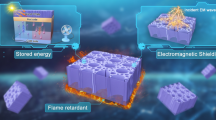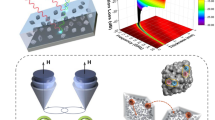Abstract
Delignified wood (DW) is natural wood’s cellulosic skeleton. It has highly ordered anisotropic architecture, permitting solute accessibility to modify its abundant interior surfaces. Herein, we demonstrate a facile method to coat polydopamine (PDA) conformally on DW’s interior surfaces. The PDA layer not only introduced heteroatom (N), but also facilitated the generation of silver particles by in situ reduction. The prepared DW skeletons were freeze-dried and pyrolyzed at 850/1200 °C to create carbonized DW (CDW) and then embedded in the epoxy matrix to prepare a composite for the application of electromagnetic interference (EMI) shielding. It was found that the PDA coating converted to a highly conductive carbon species on the surface of a DW-derived carbon scaffold. As a result, the PDA modification increased the electrical conductivity (EC) of the plain epoxy/CDW from 0.32 to 0.46 S/m, and accordingly the EMI shielding effectiveness (SE) increased from 18.2 dB for epoxy/CDW to 24.0 dB for epoxy/CDW-PDA, and 30.6 dB for epoxy/CDW-Ag. This work provides a facile and universal methodology to enhance the EC and EMI SE performance of open-porous carbon.
Graphical abstract








Similar content being viewed by others
References
Jiang D, Murugadoss V, Wang Y et al (2019) Electromagnetic interference shielding polymers and nanocomposites: a review. Polym Rev 59:280–337
Lee B, Woo W, Park H, Hahm H, Wu J, Kim M (2002) Influence of aspect ratio and skin effect on EMI shielding of coating materials fabricated with carbon nanofiber/PVDF. J Mater Sci 37:1839–1843. https://doi.org/10.1023/A:1014970528482
Chen W, Duan W, Liu Y, Wang Q, Qi F (2019) Facile fabrication of multifunctional polymer composites based on three-dimensional interconnected networks of graphene and carbon nanotubes. Ind Eng Chem Res 58:21531–21541
Zhang L-Q, Yang S-G, Li L et al (2018) Ultralight cellulose porous composites with manipulated porous structure and carbon nanotube distribution for promising electromagnetic interference shielding. ACS Appl Mater Interfaces 10:40156–40167
Hamidinejad M, Zhao B, Zandieh A, Moghimian N, Filleter T, Park CB (2018) Enhanced electrical and electromagnetic interference shielding properties of polymer–graphene nanoplatelet composites fabricated via supercritical-fluid treatment and physical foaming. ACS Appl Mater Interfaces 10:30752–30761
Wang S, Huang Y, Zhao C et al (2020) Theoretical modeling and experimental verification of percolation threshold with MWCNTs’ rotation and translation around a growing bubble in conductive polymer composite foams. Compos Sci Technol 199:108345. https://doi.org/10.1016/j.compscitech.2020.108345
Shen B, Li Y, Yi D, Zhai W, Wei X, Zheng W (2016) Microcellular graphene foam for improved broadband electromagnetic interference shielding. Carbon 102:154–160
Song W-L, Cao M-S, Fan L-Z et al (2014) Highly ordered porous carbon/wax composites for effective electromagnetic attenuation and shielding. Carbon 77:130–142
Zeng Z, Jin H, Chen M, Li W, Zhou L, Zhang Z (2016) Lightweight and anisotropic porous MWCNT/WPU composites for ultrahigh performance electromagnetic interference shielding. Adv Func Mater 26:303–310
Zeng Z, Jin H, Chen M et al (2017) Microstructure design of lightweight, flexible, and high electromagnetic shielding porous multiwalled carbon nanotube/polymer composites. Small 13:1701388. https://doi.org/10.1002/smll.201701388
Jiang F, Li T, Li Y et al (2018) Wood-based nanotechnologies toward sustainability. Adv Mater 30:1703453. https://doi.org/10.1002/adma.201703453
Wang K, Liu X, Tan Y, Zhang W, Zhang S, Li J (2019) Two-dimensional membrane and three-dimensional bulk aerogel materials via top–down wood nanotechnology for multibehavioral and reusable oil/water separation. Chem Eng J 371:769–780
Shen Z, Feng J (2019) Preparation of thermally conductive polymer composites with good electromagnetic interference shielding efficiency based on natural wood-derived carbon scaffolds. ACS Sustain Chem Eng 7:6259–6266
Xu L, Xiong Y, Dang B et al (2019) In-situ anchoring of Fe3O4/ZIF-67 dodecahedrons in highly compressible wood aerogel with excellent microwave absorption properties. Mater Des 182:108006. https://doi.org/10.1016/j.matdes.2019.108006
Cheng Z, Wei Y, Liu C et al (2020) Lightweight and construable magnetic wood for electromagnetic interference shielding. Adv Eng Mater 22:2000257. https://doi.org/10.1002/adem.202000257
Gan W, Chen C, Giroux M et al (2020) Conductive wood for high-performance structural electromagnetic interference shielding. Chem Mater 32:5280–5289. https://doi.org/10.1021/acs.chemmater.0c01507
Yuan Y, Sun X, Yang M et al (2017) Stiff, thermally stable and highly anisotropic wood-derived carbon composite monoliths for electromagnetic interference shielding. ACS Appl Mater Interfaces 9:21371–21381
Ryu JH, Messersmith PB, Lee H (2018) Polydopamine surface chemistry: a decade of discovery. ACS Appl Mater Interfaces 10:7523–7540. https://doi.org/10.1021/acsami.7b19865
Lu Z, Xiao J, Wang Y, Meng M (2015) In situ synthesis of silver nanoparticles uniformly distributed on polydopamine-coated silk fibers for antibacterial application. J Colloid Interface Sci 452:8–14
Shafei S, Foroughi J, Stevens L, Wong CS, Zabihi O, Naebe M (2017) Electroactive nanostructured scaffold produced by controlled deposition of PPy on electrospun PCL fibres. Res Chem Intermed 43:1235–1251
Zheng T, Clemons CM, Pilla S (2020) A comparative study of direct compounding, coupling agent-aided and initiator-aided reactive extrusion to prepare cellulose nanocrystal/PHBV (CNC/PHBV) nanocomposites. ACS Sustain Chem Eng. https://doi.org/10.1021/acssuschemeng.9b04867
Liang Y, Liu H, Li Z, Fu R, Wu D (2013) In situ polydopamine coating-directed synthesis of nitrogen-doped ordered nanoporous carbons with superior performance in supercapacitors. J Mater Chem A 1:15207–15211
Kong J, Yee WA, Yang L et al (2012) Highly electrically conductive layered carbon derived from polydopamine and its functions in SnO 2-based lithium ion battery anodes. Chem Commun 48:10316–10318
Chen W, Yu H, Lee SY, Wei T, Li J, Fan Z (2018) Nanocellulose: a promising nanomaterial for advanced electrochemical energy storage. Chem Soc Rev 47:2837–2872. https://doi.org/10.1039/C7CS00790F
Li R, Parvez K, Hinkel F, Feng X, Müllen K (2013) Bioinspired wafer-scale production of highly stretchable carbon films for transparent conductive electrodes. Angew Chem Int Ed 52:5535–5538
Sabet SM, Mahfuz H, Terentis AC, Hashemi J, Boesl B (2016) A facile approach to the synthesis of multi-walled carbon nanotube-polyhedral oligomeric silsesquioxane (POSS) nanohybrids. Mater Lett 168:9–12
Ferrari AC, Meyer J, Scardaci V et al (2006) Raman spectrum of graphene and graphene layers. Phys Rev Lett 97:187401. https://doi.org/10.1103/PhysRevLett.97.187401
Ismagilov ZR, Shalagina AE, Podyacheva OY et al (2009) Structure and electrical conductivity of nitrogen-doped carbon nanofibers. Carbon 47:1922–1929
Wen B, Cao M-S, Hou Z-L et al (2013) Temperature dependent microwave attenuation behavior for carbon-nanotube/silica composites. Carbon 65:124–139
Neill SP, Hashemi MR (2018) Fundamentals of ocean renewable energy: generating electricity from the sea. Academic Press, Cambridge
Al-Saleh MH, Saadeh WH, Sundararaj U (2013) EMI shielding effectiveness of carbon based nanostructured polymeric materials: a comparative study. Carbon 60:146–156
Yan DX, Pang H, Li B et al (2015) Structured reduced graphene oxide/polymer composites for ultra-efficient electromagnetic interference shielding. Adv Func Mater 25:559–566
Ghosh P, Chakrabarti A (2000) Conducting carbon black filled EPDM vulcanizates: assessment of dependence of physical and mechanical properties and conducting character on variation of filler loading. Eur Polym J 36:1043–1054
Duan H, Zhu H, Yang Y, Hou T, Zhao G, Liu Y (2018) Facile and economical fabrication of conductive polyamide 6 composites with segregated expanded graphite networks for efficient electromagnetic interference shielding. J Mater Sci: Mater Electron 29:1058–1064
Madani M (2010) Conducting carbon black filled NR/IIR blend vulcanizates: assessment of the dependence of physical and mechanical properties and electromagnetic interference shielding on variation of filler loading. J Polym Res 17:53–62
Li Y-Q, Samad YA, Polychronopoulou K, Liao K (2015) Lightweight and highly conductive aerogel-like carbon from sugarcane with superior mechanical and EMI shielding properties. ACS Sustain Chem Eng 3:1419–1427
Zeng Z, Zhang Y, Ma XYD et al (2018) Biomass-based honeycomb-like architectures for preparation of robust carbon foams with high electromagnetic interference shielding performance. Carbon 140:227–236
Wan C, Li J (2017) Synthesis and electromagnetic interference shielding of cellulose-derived carbon aerogels functionalized with α-Fe2O3 and polypyrrole. Carbohyd Polym 161:158–165
Zhou Z-H, Liang Y, Huang H-D et al (2019) Structuring dense three-dimensional sheet-like skeleton networks in biomass-derived carbon aerogels for efficient electromagnetic interference shielding. Carbon 152:316–324
Liu Q, Gu J, Zhang W, Miyamoto Y, Chen Z, Zhang D (2012) Biomorphic porous graphitic carbon for electromagnetic interference shielding. J Mater Chem 22:21183–21188
Yuan Y, Ding Y, Wang C et al (2016) Multifunctional stiff carbon foam derived from bread. ACS Appl Mater Interfaces 8:16852–16861
Ma X, Shen B, Zhang L et al (2019) Novel straw-derived carbon materials for electromagnetic interference shielding: a waste-to-wealth and sustainable initiative. ACS Sustain Chem Eng 7:9663–9670
Jia X, Shen B, Chen Z, Zhang L, Zheng W (2019) High-performance carbonized waste corrugated boards reinforced with epoxy coating as lightweight structured electromagnetic shields. ACS Sustain Chem Eng 7:18718–18725
Acknowledgements
The authors would like to acknowledge the financial support by the USDA National Institute of Food and Agriculture, AFRI project [contract#2016-67021-25016], US Endowment for Forestry and Communities [grant number: E17-18], Robert Patrick Jenkins Professorship, and Dean’s Faculty Fellow Professorship. Ting Zheng would like to acknowledge partial financial support provided by Cooper-Standard Postdoctoral Fellowship.
Author information
Authors and Affiliations
Corresponding author
Ethics declarations
Conflict of interest
The authors declare that they have no conflict of interest.
Additional information
Handling Editor: Stephen Eichhorn.
Publisher's Note
Springer Nature remains neutral with regard to jurisdictional claims in published maps and institutional affiliations.
Supplementary Information
Below is the link to the electronic supplementary material.
10853_2021_6007_MOESM1_ESM.docx
Fig S1–S3: preliminary study including the preparation of DW/PPy and DW/MWCNT and their SEI shielding performance. Figure S4: SEM images of wood, CDW, CDW-PDA and CDW-Ag; Fig S5. Cross section of PDA-treated DW after 2 h and 24 h; Fig S6: \({\mathrm{SE}}_{T}\), \({\mathrm{SE}}_{R}\), and \({\mathrm{SE}}_{A}\) of epoxy/CDW, epoxy/CDW-PDA, and epoxy/CDW-Ag; Fig S7. \({\mathrm{SE}}_{A}\)% (\({\mathrm{SE}}_{A}\)/\({\mathrm{SE}}_{T}\)) of composites from porous carbons carbonized at 850 °C and 1200 °C; Table S1: dimension and density of specimens. Table S2. Atom percentage of DW-Ag over depth on its cross section (by XPS); Table S3 and S4: EMI SE performance of biomass-based porous carbon and carbon-filled CPC (DOCX 8444 kb)
Rights and permissions
About this article
Cite this article
Zheng, T., Sabet, S.M. & Pilla, S. Polydopamine coating improves electromagnetic interference shielding of delignified wood-derived carbon scaffold. J Mater Sci 56, 10915–10925 (2021). https://doi.org/10.1007/s10853-021-06007-9
Received:
Accepted:
Published:
Issue Date:
DOI: https://doi.org/10.1007/s10853-021-06007-9




